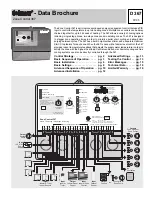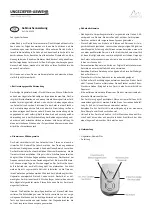
9
Test the Sensors
In order to test the sensors and Room Temperature Units (RTUs), the actual temperature
at each sensor and RTU location must be measured. A good quality digital thermometer
with a surface temperature probe is recommended for ease of use and accuracy of
testing. Where a digital thermometer is not available, a spare sensor can be strapped
alongside the one to be tested and the readings compared. Test the sensors and RTU(s)
according to the instructions in the Data Brochures D 070 and D 054.
Test the Power Supply
Make sure exposed wires or bare terminals are not in contact with other wires or grounded surfaces. Turn on the power and measure
the voltage between the
Power N — L (3 and 4) terminals using an AC voltmeter. The reading should be between 110 and 130 V (ac).
Test the Outputs
System Pump
If a system pump is connected to the
System Pmp — System Pmp (1 and 2) terminals, make sure power to the terminal block is
off and install a jumper between the terminals. When the system pump circuit is powered up, the system pump should start. If the
pump does not turn on, check the wiring between the terminal block and the pump and refer to any installation or troubleshooting
information supplied with the pump. If the pump operates properly, disconnect the power and remove the jumper.
Cooling
If a cooling system is connected to the terminals
Com 1-2 —1 (19 and 20), make sure power to the pump or valve circuit is off and
install a jumper between the terminals
Com 1-2 — 1 (19 and 20). When the zone circuit is powered up, the zone pump should turn
on or the zone valve should open completely. If no response occurs, check the wiring between the terminal and the pump or valve
and refer to any installation or troubleshooting information supplied with these devices.
Zone Pump or Valve
• If a zone pump or valve is connected to the terminals
Com 5-6 —6 (25 and 27), follow a similar procedure as described above
in the cooling section for the zone 1 relay.
• If a zone pump or valve is connected to the terminals
Com 5-6 — 5 (25 and 26), follow a similar procedure as described above
in the cooling section for the zone 1 relay.
• If a zone pump or valve is connected to the terminals
Com 3-4 — 4 (22 and 24), follow a similar procedure as described above
in the cooling section for the zone 1 relay.
• If a zone pump or valve is connected to the terminals
Com 3-4 — 3 (22 and 23), follow a similar procedure as described above
in the cooling section for the zone 1 relay.
• If a zone pump or valve is connected to the terminals
Com 1-2 — 2 (19 and 21), follow a similar procedure as described above
in the cooling section for the zone 1 relay.
• If a zone pump or valve is connected to the terminals
Com 1-2 — 1 (19 and 20), follow a similar procedure as described above
in the cooling section for the zone 1 relay.
Connect the Control
• Make sure all power to the devices and terminal blocks is off and remove any remaining jumpers from the terminals.
• Reconnect the terminal blocks to the control by carefully aligning them with their respective headers on the control and then pushing
the terminal blocks into the headers. The terminal blocks should snap firmly into place.
• Install the supplied safety dividers between the unpowered sensor inputs and the powered 120 V (ac) or 24V (ac) wiring chambers.
• Do not apply power to the control until the adjustment dials and DIP switches are properly set for your application. See the Basic
Settings section of this brochure for details on how to set the dials and DIP switches.
• Once the settings are complete, apply power to the control. The operation of the control on power up is described in the Basic
Sequence of Operation section of this brochure.
Basic Settings
Before adjusting the dial settings, read through the sequence of operation section of this brochure to ensure that you understand how
the control operates.
STEP SIX
ESSENTIAL CONTROL SETTINGS
Max. Room
The
Max. Room dial is used to prevent excessive desired indoor temperature settings
during heating operation. If an
RTU dial is set above the Max. Room dial, the Max. Room
dial becomes the desired indoor temperature. This is useful in situations where a tenant
has control of the RTU but the owner pays the fuel costs.
Design Outdoor
This dial must be set to the
Off position unless the Demand Limiting function is used. See
the Advanced section of this brochure for more information.
Max. Room
40
65
°
F
Off
85
0
°
F
-40
Off
Design Outdoor
30
Ω
Ω

































